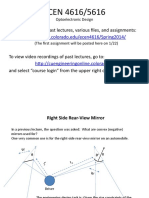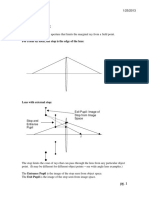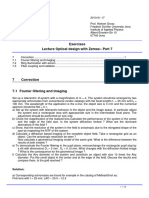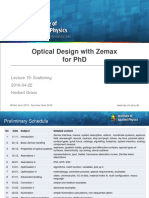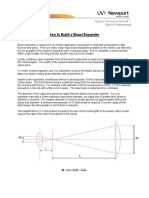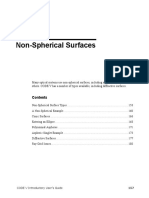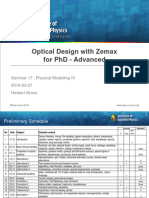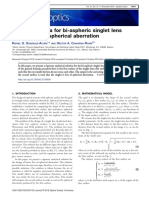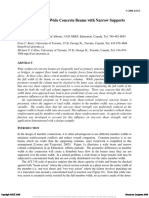Optimisation
Lecture 3
�Objectives: Lecture 3
At the end of this lecture you should:
1. Understand the use of Petzval curvature to
balance lens components
2. Know how different aberrations depend on
field angle or pupil zone
3. Understand the basics of the Zemax merit
function and the Zemax operands
4. Be able to progressively optimise a
complex lens system to achieve the final
performance requirements
March 10, 2015
Optical Systems Design
�Petzval Surface & Petzval
Curvature
Theoretical best image surface which
exhibits no astigmatism
P
=
n n where = n2 n1 is the
Petzval sum
1 2
r
optical power of each surface
P
=
For simple lenses
n where is the
power of each lens (reciprocal of focal
length) and n is the refractive index
Minimizing Petzval curvature produces a
flat, anastigmatic image plane
March 10, 2015
Optical Systems Design
�Aberration Dependance on
Aperture and Field
Aperture Exponent
Field Exponent
Longitudinal colour
Lateral colour
Spherical aberration
Coma
Astigmatism
Field curvature
Distortion
Stopping down a lens can make a big difference on spherical aberration
Stopping down a lens wont improve the distortion
For wide-angle lenses, astigmatism is harder to control than coma
Symmetrical systems (about stop) minimise lateral colour, coma & distortion
March 10, 2015
Optical Systems Design
�Optimisation Process
Enter a starting lens configuration
Allow Zemax to change lens
parameters to improve performance
Requires a measure of performance
merit function (error function)
Optimisation tries to minimise merit
function (gradient search or Hammer)
March 10, 2015
Optical Systems Design
�Constituents of Merit Function
Measures of:
1. How well first-order properties are
satisfied (e.g. paraxial focus, locations of
pupils and images)
2. How well special constraints are satisfied
(e.g. element centre or edge thickness,
curvatures, glass properties)
3. How well aberrations are controlled (e.g.
image sharpness and distortion)
March 10, 2015
Optical Systems Design
�Image Sharpness metrics
1. Spot size measured by ray-intercept
errors in image plane
2. Wavefront imperfections measured
by optical path difference (OPD)
errors in the exit pupil
3. Modulation transfer function (MTF) in
the image plane
(Start with [1], moving to [2] or [3] only in final
optimisation stages)
March 10, 2015
Optical Systems Design
�Optimization Operands
Individual components of the merit function
which are assigned a target value and
weights
Number of operands often greatly exceeds
the number of independent lens variables
Apply iterative least squares optimisation to
minimise the (weighted) deviations between
operands and their target values
March 10, 2015
Optical Systems Design
�Zemax Operands
March 10, 2015
Optical Systems Design
�Zemax Operands
Zemax has over 300 user-selectable operands (see
OpticStudio manual, p. 259)
Mostly used to supplement a default merit function
(now called Sequential Merit Function)
Weights = 0 ignored, weights < 0 treated as a
Lagrangian multiplier ( weight)
OptimizationWizard adds the default merit
function
Can also have user-defined operands (ZPL)
Spherical
Coma
SPHA,
REAY
COMA, ASTI,
TRAY
TRAX,TRAY
March 10, 2015
Astigmatism Field
Curvature
FCUR
Distortion
Long.
Colour
Lateral
Colour
DIMX,
DIST
AXCL
LACL
Optical Systems Design
10
�Optimisation Techniques
Choose starting design carefully (e.g.
scale from existing lens catalogue)
Develop optimisation approach that is
systematic & rationale
Sheperd design in direction intended
Do continuous sanity checks
Discard poor solutions as they arise
March 10, 2015
Optical Systems Design
11
�Optimisation Wizard
March 10, 2015
Optical Systems Design
12
�Early Optimisations
Reduce number of independent
variables
Freeze glass types and use pickup solves
to symmetrise configurations
Replace large RoC surfaces with planes
Include first order (paraxial) properties
and boundary conditions (e.g. back focal
length) in merit function
March 10, 2015
Optical Systems Design
13
�Intermediate Optimisations
Start to control on-axis and off-axis
aberrations
Chromatic aberrations using only two
extreme wavelengths
Monochromatic aberrations using single
central wavelength
Typically: longitudinal & lateral colour,
spherical & distortion
Keep image plane at paraxial focus
March 10, 2015
Optical Systems Design
14
�Final Optimisations
Shrink polychromatic spots for all field angles
Use several wavelengths across the band
Re-optimise using wavefront OPDs in exit
pupil rather than transverse ray errors (spots)
on image surface
Allow small amount of paraxial defocussing
Include any deliberate mechanical
vignetting
Take a critical look at the final lens & its
performance
March 10, 2015
Optical Systems Design
15
�Potential Problem Areas
Avoid systems which attempt to balance lenses
with large amounts of positive and negative
power
Avoid highly curved surfaces and grazing rays
Look out for designs which have individual
elements which stand out as either very strong
(split) or very weak (eliminate)
Watch for variables that are only weakly effective
Avoid aspherics unless really necessary
Avoid glasses with undesirable properties (e.g. low
transmission, softness)
March 10, 2015
Optical Systems Design
16
�Example: Cooke Triplet (1983)
One of 1st fast, wide-field photographic lenses.
Consists of two positive singlets and one negative
singlet (all thin lenses)
Negative element located about halfway
between positive elements to maintain a large
amount of symmetry
8 major variables (6 radii, 2 spacings).
10/03/2015
Optical Systems Design
17
�Early Optimisation
10/03/2015
Optical Systems Design
18
�Intermediate Optimisation
10/03/2015
Optical Systems Design
19
�Final Optimisation
10/03/2015
Optical Systems Design
20
�Balancing Aberrations
Analyse > Aberrations > Seidel Diagram
10/03/2015
Optical Systems Design
21
�Summary: Lecture 3
Minimising the Petzval sum can give a good
starting point for lens optimisation
Proper use of the Zemax optimisation tools is the
key to successful lens design
Optmisation using spot size (ray intercept errors) is
more stable than OPD errors and should normally
be used first
Whilst the Zemax default merit function gives a
good starting point, in many cases it will need
supplementing with individual user-selected
operands to achieve the desired constraints
March 10, 2015
Optical Systems Design
22
�Exercises: Lecture 3
Repeat the analysis of a Cooke triplet to work at
F/3.5 which has a 52mm focal length, starting
from COOKE-LECT3-EARLY.ZMX on course www
page (Lecture 3).
Assume wavelengths of 0.45,0.50,0.55,0.60 & 0.65
m and field angles of 0o,9o,16o & 22o
Place the aperture stop between the 2nd and 3rd
lenses and use LaFN21 & SF53 for the glass types
Optimize the performance on the paraxial focal
plane, so that the lens still performs well when
stopped down
March 10, 2015
Optical Systems Design
23

